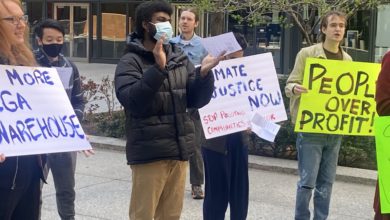The U.S. Southwest should be the canary in the climate change coal mine. Water, an already precious resource in the arid ecosystems of this region, is in critically short supply. And alongside rising temperatures and water shortages, the anarchic capitalist model for the development of cities in the Southwest may make them completely uninhabitable in the near future.
The Rio Grande and Colorado Rivers, two primary sources of water in the Southwest, put to the fore this horrifying trend of water scarcity. This summer, large stretches of the Rio Grande are already completely dry — some areas drier much earlier than in previous years, and others dry that have never been without water. Agricultural megacorporations and other capitalists have exacerbated these conditions.
Water crises and capitalist corporations go hand in hand in New Mexico
Despite chronic drought and warming temperatures, large corporations continue to exploit New Mexico’s limited water resources. In March 2021, the town of Los Lunas protested Facebook’s proposal to use five percent of the city’s water allocation for its new data center, but the plan was readily accepted by the city council. This development occurred just a month after protests by local residents and small farmers in February 2021 successfully stopped the expansion of the Niagara Bottling Company’s access to the town’s water.
Water crises in New Mexico have a long history. Like much of the American West, New Mexico suffered greatly during the Dust Bowl, which was directly a result of capitalist farming practices. Subsequent droughts and the erosion of precious topsoils that have sustained human life for centuries have continued to the present day, along with the market-driven farming practices that cause them.
Evidence of the rapid and significant environmental consequences of corporations’ misuse of New Mexican land is already readily apparent. For instance, only 14 of New Mexico’s 27 native fish populations remain. Dryland farmers (who depend exclusively on rainfall to grow crops) are sometimes seeing a 40% drop in crop yields year-to-year, as well as a return of Dust Bowl-esque dust storms.
Decades of irresponsible water management have allowed invasive species like the Salt Cedar to overtake native cottonwoods and grasses in the delicate ecosystem of the Chihuahuan desert near Las Cruces. The average temperature in New Mexico has risen by 2.7 degrees Fahrenheit since the 1970s. Aquifers are being “mined to extinction” across the state as all tributary flows decline. And between June and September of 2020, during the monsoon season that the state relies on for water and moisture, precipitation has fallen between 52 to 72 percent from previous years.
A fundamental problem is that New Mexico’s economy remains heavily reliant on fossil fuels, and their extraction, especially by fracking, requires tons of water. The fracking boom in the Permian basin on the Texas-New Mexico border shows no signs of slowing down. After a slight dip in production in early 2020, by December 2020, extraction was occurring again at a rate of four million barrels of oil and 16,901 million cubic feet of natural gas per day. Despite the constant drought and dire future for the state, capitalists continue to exploit New Mexico’s water supply to produce profit for an environmentally destructive industry.
By 2070, the snowpack that supplies the Rio Grande and Pecos rivers, the two largest in New Mexico, is expected to be depleted by 70 percent, if not entirely. UCLA and Colorado State University scientists have reached a similar conclusion on the state of the Colorado River, which supplies water to seven states before crossing into Mexico. The study concluded that 53 percent of the decrease in flow is attributable to global warming and the lack of snow.
The water crisis affects Indigenous communities the most
Water theft, decreasing resources and environmental destruction all have a devastating impact on all in the Southwest, but this affects Native American communities the most. These communities have the longest history of stolen and contaminated water. The most egregious example of this devastation took place on July 16, 1979, when one thousand tons of solid nuclear waste and ninety-three gallons of radioactive tailings were dumped into the Puerco River near Church Rock, New Mexico. There was no effort to warn the mostly Navajo residents. There has been little coverage of the incident and no real compensation for victims of the disaster and no serious consequences for the company responsible.
For Indigenous communities, the lack of water compounds other crises. For instance, the rapid spread of COVID among Native people was made far worse by the lack of clean water. The Navajo Nation had an infection rate 21 percent higher than that of New York City during that city’s peak infection rate. The lack of clean water for the thirty tribes living in the Colorado River Basin (in which a significant portion of the Navajo Nation lies) meant not being able to clean surfaces or practice hygiene needed to prevent the spread of the virus. This water could have been available and ready in such a time of crisis, were it not being siphoned off before reaching the basin and diverted to industrial farms and ranches elsewhere.
The inter-tribal and academic report Universal Access to Clean Water for Tribes in the Colorado River Basin contains many shocking revelations on the reality of water in the basin. Heather Tanana, a research professor at the University of Utah’s law school and lead author of the report, states that “most of the 2 million Americans without running water and basic indoor plumbing are Native American, making race the most common factor in water insecurity.” Only one of every three Navajo Nation homes has running water. On the Hopi reservation in eastern Arizona, 75 percent of people rely on water that is contaminated with excessive levels of arsenic. Limited access to grocery stores in an area the size of West Virginia means purchasing water is not a viable option. These dire conditions are a direct result of corporate domination over any concern for sustainability or human life.
What is the solution to the capitalist climate crisis?
Without immediate and rapid change, New Mexico and other areas will plunge further into drought and irreversible environmental damage. In order to prevent more deaths, the spread of disease, and an end to the planet we live on, we must end the anarchy of capitalist agricultural production, fossil fuel extraction and the misuse of our water. Only with the democratic control of water resources by the people of New Mexico, Colorado, Arizona, Utah, Nevada and all similar regions in crisis will there be a system that puts people and the survival of the earth before profit. This means rejecting capitalist exploitation and embracing socialism before it is too late.
Photo: Wikimedia commons, the Rio Grande from the Rio Grande Gorge Bridge near Taos, New Mexico






